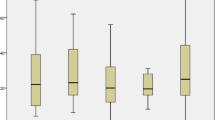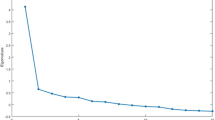Abstract
Purpose The neck disability index (NDI) as a 10-item patient reported outcome (PRO) measure is the most commonly used whiplash associated disorders (WAD) assessment tool. However, statistical rigor and factor structure are not definitive. To date, confirmatory factor analysis (CFA) has not examined whether the factor structure generalizes across different groups (e.g., WAD versus non-WAD). This study aimed to determine the psychometric properties of the NDI in these population groups.
Methods
This study used CFA to analyze NDI baseline-data for WAD (n = 804; 69 % females) and non-WAD (n = 963; 67 % females), each for the full sample and separate genders. Invariance analyses examined the NDI structure across the four groups.
Results
Across both populations and gender subgroups the one-factor solutions consistently showed better model fit over two-factor solutions. The NDI was best characterized as one-dimensional and invariant across multiple sub-groups.
Conclusion
The NDI remains a valid PRO in WAD populations that provides acceptable measurement of neck status that is appropriate for basic functional assessment across genders. However, it is recommended that both clinicians and researchers initiate the transition toward more rigorous and less ambiguous PRO measurement tools for WAD patients and research. This future graduated movement toward other PROs should consider both regional PROs and computerized decision support systems, initially measured concurrently with the NDI to establish ways to convert existing scored data prior to their singular use.
Similar content being viewed by others
References
Jensen TS, Kasch H, Bach FW, Bendix T, Kongsted A (2010) Definition, classification and epidemiology of whiplash—article in Danish. Ugeskr Laeger 172:1812–1814
Angst F, Gantenbein AR, Lehmann S, Gysi-Klaus F, Aeschlimann A, Michel BA, Hegemann F (2014) Multidimensional associative factors for improvement in pain, function, and working capacity after rehabilitation of whiplash associated disorder: a prognostic, prospective outcome study. BMC Musculoskelet Disord 15:130. doi:10.1186/1471-2474-15-130
de Vet HCW, Terwee CB, Mokkink LB (2011) Measurement in medicine a practical guide. Cambridge Press, London
Vernon H, Mior S (1991) The neck disability index: a study of reliability and validity. J Manipulative Physiol Ther 14:409–415
Gabel CP, Burkett B, Neller A, Yelland M (2008) Can long term impairment in general practitioner whiplash patients be predicted using screening and patient report outcomes? Int J Rehabil Res 31:79–80
Wenzel HG, Vasseljen O, Mykletun A, Nilsen TI (2012) Pre-injury health-related factors in relation to self-reported whiplash: longitudinal data from the HUNT study, Norway. Eur Spine J 21:1528–1535. doi:10.1007/s00586-012-2186-2
Wenzel HG, Mykletun A, Nilsen TI (2009) Symptom profile of persons self-reporting whiplash: a Norwegian population-based study (HUNT 2). Eur Spine J 18:1363–1370. doi:10.1007/s00586-009-1106-6
Hoy D, March L, Woolf A, Blyth F, Brooks P, Smith E, Vos T, Barendregt J, Blore J, Murray C, Burstein R, Buchbinder R (2014) The global burden of neck pain: estimates from the Global Burden of Disease 2010 study. Ann Rheum Dis 73:1309–1315. doi:10.1136/annrheumdis-2013-204431
Sterling M (2006) Balancing the ‘bio’ with the psychosocial in whiplash associated disorders. Man Ther 11:180–181
MacDermid JC, Walton DM, Avery S, Blanchard A, Etruw E, McAlpine C, Goldsmith CH, MacDermid JC (2009) Measurement properties of the neck disability index: a systematic review. J Orthop Sports Phys Ther 39:334–350
Rebbeck T, Maher C, Refshauge KM (2006) Evaluating two implementation strategies for whiplash guidelines in physiotherapy: a cluster randomised trial. Aust J Physiother 52:165–174
Pinfold M, Niere KR, O’Leary EF, Hoving JL, Green S, Buchbinder R (2004) Validity and internal consistency of a whiplash-specific disability measure. Spine 29:263–268
Stupar M, Côté P, Beaton DE, Boyle E, Cassidy JD (2015) Structural and construct validity of the whiplash disability questionnaire in adults with acute whiplash-associated disorders. Spine J. doi:10.1016/j.spinee.2015.07.006
Schmitt MA, Stenneberg MS, Schrama PP, van Meeteren NL, Helders PJ, Schröder CD (2013) Measurement of clinically relevant functional health perceptions in patients with whiplash-associated disorders: the development of the whiplash specific activity and participation list (WAL). Eur Spine J 22:2097–2104
Feise RJ, Menke JM (2001) Functional Rating Index. A new valid and reliable instrument to measure the magnitude of clinical change in spinal conditions. Spine 26:78–86
Gabel CP, Melloh M, Burkett B, Michener LA (2014) The Spine Functional Index: development and clinimetric validation of a new whole-spine functional outcome measure. Spine J. doi:10.1016/j.spinee.2013.09.055
Liang MH, Jette AM (1981) Measuring functional ability in chronic arthritis: a critical review. Arthritis Rheum 24:80–86
Gabel CP, Burkett B, Yelland M (2009) Balancing fidelity and practicality in short version musculoskeletal outcome measures. Phys Ther Rev 14:221–225
Ware JEJ, Gandek B, Sinclair SJ, Bjorner JB (2005) Item response theory and computerised adaptive testing: implications for outcome measurement in rehabilitation. Rehabil Psychol 50:71–78
Tulsky DS, Carlozzi NE, Cella D (2011) Advances in outcomes measurement in rehabilitation medicine: current initiatives from the National Institutes of Health and the National Institute on Disability and Rehabilitation Research. Arch Phys Med Rehabil 92:S1–S6. doi:10.1016/j.apmr.2011.07.202
Nieto R, Miró J, Huguet A (2008) Disability in subacute whiplash patients: usefulness of the neck disability index. Spine 33:E630–E635
Gabel CP, Melloh M, Cuesta-Vargas AI (2011) Letter to the Editor Re Pickering PM, Osmotherly PG, Attia JR et al. An examination of outcome measures for pain and dysfunction in the cervical spine: a factor analysis. Spine 2011;36(7):581–588. Spine 36:1815
Hains F, Waalen J, Mior S (1998) Psychometric properties of the neck disability index. J Manipulative Physiol Ther 21:75–80
Young SB, Aprill C, Braswell J, Ogard W, Richards JS, McCarthy JP (2009) Psychological factors and domains of neck pain disability. Pain Med 10:310–318
van der Velde G, Beaton D, Hogg-Johnston S, Hurwitz E, Tennant A (2009) Rasch analysis provides new insights into the measurement properties of the neck disability index. Arthritis Rheum 61:544–551
Gabel CP, Cuesta-Vargas AI, Osborne JO, Burkett B, Melloh M (2014) Confirmatory factory analysis of the neck disability index indicates a one-factor model. Spine J 14:1410–1416. doi:10.1016/j.spinee.2013.08.026
Osborne J (2007) Best practices in quantitative methods. Sage Publications Thousand Oaks, California
Walton DM, MacDermid JC (2013) A brief 5-item version of the neck disability index shows good psychometric properties. Health Qual Life Outcomes. doi:10.1186/1477-7525-11-108
Swanenburg J, Humphreys K, Langenfeld A, Brunner F, Wirth B (2013) Validity and reliability of a German version of the neck disability index (NDI-G). Man Ther. doi:10.1016/j.math.2013.07.004
Johansen JB, Andelic N, Bakke E, Holter EB, Mengshoel AM, Røe C (2013) Measurement properties of the Norwegian version of the neck disability index in chronic neck pain. Spine (Phila Pa 1976) 38:851–856. doi:10.1097/BRS.0b013e31827fc3e9
Cuesta-Vargas AI, Gabel CP (2014) Validation of a Spanish version of the spine functional index. Health Qual Life Outcomes 12:96. http://www.hqlo.com/content/12/1/96
Takasaki H, Johnston V, Treleaven JM, Jull GA (2012) The Neck Pain Driving Index (NPDI) for chronic whiplash-associated disorders: development, reliability, and validity assessment. Spine J 12(10):912–920
Chien A, Eliav E, Sterling M (2010) The development of sensory hypoesthesia after whiplash injury. Clin J Pain 26:722–728
Sterling M, Jull G, Kenardy J (2006) Physical and psychological factors maintain long-term predictive capacity post-whiplash injury. Pain 122:102–108
Pickering PM, Osmotherly PG, Attia JR, McElduff P (2011) An examination of outcome measures for pain and dysfunction in the cervical spine: a factor analysis. Spine 36:581–588
Vernon H (2008) The neck disability index: state-of-the-art, 1991–2008. J Manipulative Physiol Ther 31:491–502. doi:10.1016/j.jmpt.2008.08.006
Sterling M, Kenardy J, Jull G, Vicenzino B (2003) The development of psychological changes following whiplash injury. Pain 106:481–489
Byrne BM (2010) Structural equation modeling with AMOS: basic concepts, applications, and programming. Routledge, New York
Meade AW, Johnson EC, Brady PW (2008) Power and sensitivity of alternative fit indices in tests of measurement invariance. J Appl Psychol 93:568–592. doi:10.1037/0021-9010.93.3.568
Cheung GW, Rensvold RB (2002) Evaluating goodness-of-fit indexes for testing measurement invariance. Struct Equ Model 9:233–255
Akaike H (1974) A new look at the statistical model identification. Autom Control, IEEE Trans 19:716–723. doi:10.1109/TAC.1974.1100705
Garratt A, Schmidt L, Mackintosh A, Fitzpatrick R (2002) Quality of life measurement: bibliographic study of patient assessed health outcome measures. BMJ 324:1417
Meads D, Doward L, McKenna S, Fisk J, Twiss J, Eckert B (2009) The development and validation of the Unidimensional Fatigue Impact Scale (U-FIS). Mult Scler 15:1228–1238
Stenneberg MS, Schmitt MA, van Trijffel E, Schröder CD, Lindeboom R (2015) Validation of a new questionnaire to assess the impact of whiplash associated disorders: the whiplash activity and participation list (WAL). Man Ther 20:84–89. doi:10.1016/j.math.2014.07.008
Doward LC, McKenna SP (2004) Defining patient-reported outcomes. Value Health 7:S4–S8
Costello AB, Osborne J (2005) Best practices in exploratory factor analysis: four recommendations for getting the most from your analysis. Pract Assess Res Eval 10:1–9
Hertzum-Larsen R, Petersen H, Kasch H, Bendix T (2014) Do X-ray-occult fractures play a role in chronic pain following a whiplash injury? Eur Spine J 23:1673–1679. doi:10.1007/s00586-014-3362-3
Southerst D, Stupar M, Côté P, Mior S, Stern P (2013) The reliability of measuring pain distribution and location using body pain diagrams in patients with acute whiplash-associated disorders. J Manipulative Physiol Ther 36:395–402. doi:10.1016/j.jmpt.2013.05.023
Sterling M, Jull G, Vicenzino B, Kenardy J, Darnell R (2005) Physical and psychological factors predict outcome following whiplash injury. Pain 114:141–148
Nieto R, Miró J, Huguet A, Saldaña C (2011) Are coping and catastrophising independently related to disability and depression in patients with whiplash associated disorders? Disabil Rehabil 33:389–398. doi:10.3109/09638288.2010.491576
Hung M, Stuart AR, Higgins TF, Saltzman CL, Kubiak EN (2013) Computerized adaptive testing using the PROMIS physical function item bank reduces test burden with less ceiling effects compared to the short musculoskeletal function assessment in orthopaedic trauma patients. J Orthop Trauma 28:439–443. doi:10.1097/BOT.0000000000000059
Lobach D, Sanders GD, Bright TJ, Wong A, Dhurjati R, Bristow E, Bastian L, Coeytaux R, Samsa G, Hasselblad V, Williams JW, Wing L, Musty M, Kendrick AS (2012) Enabling health care decisionmaking through clinical decision support and knowledge management. Evid Rep Technol Assess 203:1–784
Acknowledgments
We would like to thank all participating researchers and patients who contributed data to the study. This included the University of the Sunshine Coast, Queensland, Australia, Faculty of Medicine Malaga University, Spain, University of Queensland, Mobile Spine and Rehabilitation Centre USA, The Melbourne Whiplash Centre staff and patients, Victoria, Australia and Complejo Hospitalraio Ciudad de Jaen, Spain. The study was a secondary analysis of existing de-identified data that had Human Research Ethics Committee Approval from each of the contributing researchers’ institution.
Author information
Authors and Affiliations
Corresponding author
Ethics declarations
Conflict of interest
None.
Rights and permissions
About this article
Cite this article
Gabel, C.P., Cuesta-Vargas, A., Barr, S. et al. Confirmatory factor analysis of the neck disability index, comparing patients with whiplash associated disorders to a control group with non-specific neck pain. Eur Spine J 25, 2078–2086 (2016). https://doi.org/10.1007/s00586-016-4543-z
Received:
Revised:
Accepted:
Published:
Issue Date:
DOI: https://doi.org/10.1007/s00586-016-4543-z




